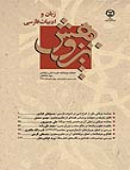بررسى سبك نثر شاعرانه در عبهرالعاشقين
محورهای موضوعی : پژوهشهای ادبیات کلاسیک ایران
1 -
کلید واژه: روزبهان بقلى شيرازى سبك عبهرالعاشقين نثر شاعرانه نثر عرفانى,
چکیده مقاله :
روزبهان بقلى شيرازى از پرآوازهترين عارفان قرن ششم است. يكى از مهمترين آثار فارسى او عبهرالعاشقين است كه جدا از اهميتى كه در شناخت عرفان عاشقانه دارد، از نظر نثر برجسته و شاعرانهاش نيز در خور توجه و تأمل است. اين مقاله سبك نثر شاعرانه عبهرالعاشقين را از سه منظر موسيقي و نظم در بيان، زبان اسلوب بيان و تخيل ـ كه مهمترين عناصر شاعرانگي كلام محسوب ميشوند ـ بررسي كرده و نمونههايي از كلام شاعرانه روزبهان را در معرض ديد و داوري مخاطبان قرار داده است. بر اساس يافتههاي اين پژوهش جلوههاى گوناگون موسيقى كلام، صور خيال، عاطفهاى عميق كه بازتاب تجربههاى عرفانى نويسنده است، زبان برجسته و خاص و ابهام برخاسته از آن، از جمله عناصرى هستند كه از نثر عبهرالعاشقين آشنايىزدايى كرده و آن را به نثري شاعرانه مبدّل ساخته كه در ميان تمامى آثار منثور عرفانى فارسى متمايز و برجسته است. روزبهان با استفاده از اين عناصر ظرفيتهاى عادى زبان معيار را براى ثبت يا بيان بخشى از تجربههاى روحانىاش كه عمدتاً منطق گريز و بيانناپذيرند افزايش داده است. از سوى ديگر به نظر مىرسد ذهن و جان زيباپسند روزبهان در اين آثار در پى شهود و ادراك زيبايى بر پهنه نثر فارسى نيز بوده است.
Roozbahan Baghli Shirazi is one of the most prominent mystics of 6th century. Abhar-ul Asheghein is one of his highly valued persian works, which is notable not only for its significance in the realm of mysticism, but also due to its rich prose. The present paper is aimed at dealing with the style of prose used in Abhar-ul Asheghein from the view point of music and order, as well as language of expression, and imagination, which are the three most significant elements of the poetic expression. The paper also introduces its readership to some forms of artistic expression created by the poets. Based on the findings of the present paper, various manifestations of imagination, rhymes, deep affection, are all reflected by the mystic experiences of the autho; moreover, the magnificent language employed by the author, as well as ambiguities deriving from this kind of language, are among the elements of defamiliarization which turn Abhar-ul Asheghin into a poetic prose; and this feature distinguishes it from all other mystic types of prose ever existed. Employing these elements, Roozbehan enhances the usual norms of the standard language, so as to express certain aspects of his spiritual experiences, which are not compatible with the logical norms, nor can they be expressed. Moreover, Roozbehan appears to have always been in search of beauty of the Persian prose, in his mind and soul.

